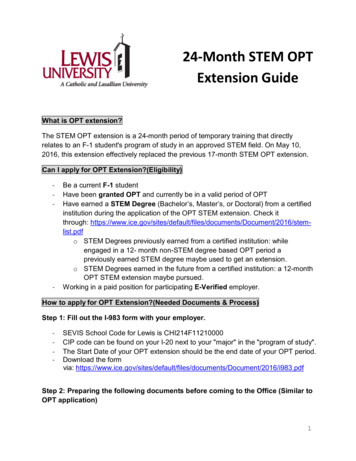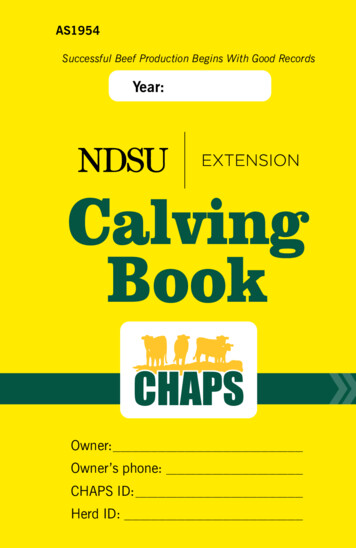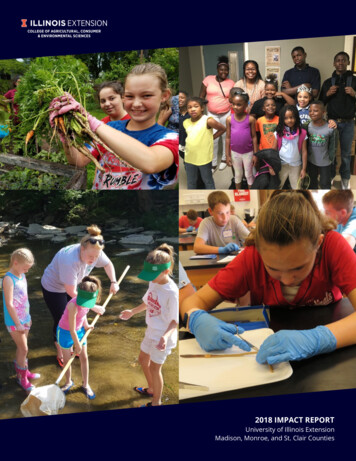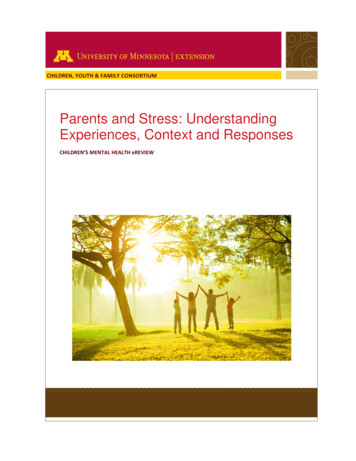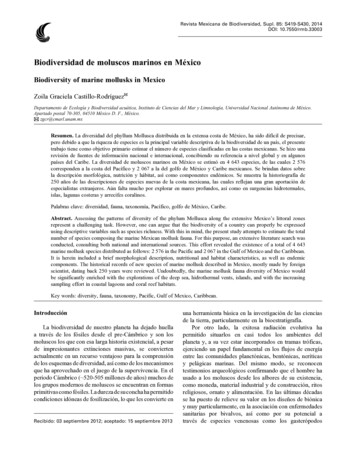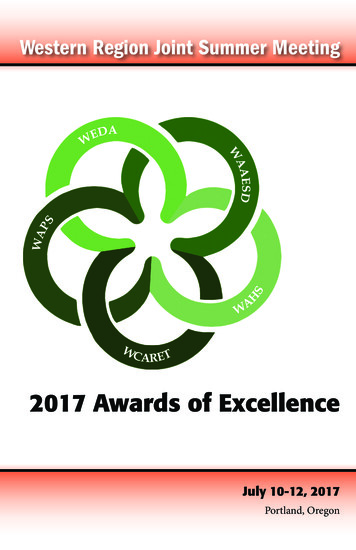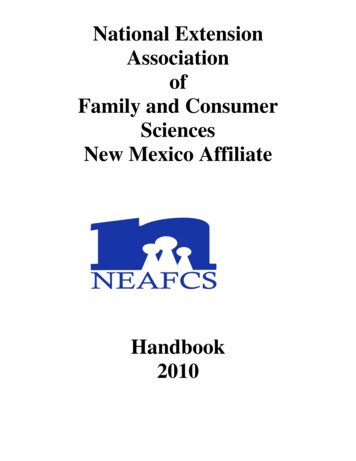
Transcription
National ExtensionAssociationofFamily and ConsumerSciencesNew Mexico AffiliateHandbook2010
National Extension Association ofFamily and Consumer SciencesOur CreedAs an extension educator my prime concern is people.I believe that it is my privilege to give to the best of my ability.It is my responsibility to develop myself to be a better teacher and an understanding friend.I accept the opportunity to help individuals, families and communities to develop to their full potential.And may I always be willing to accept the challenges of the times.Our MissionThe National Extension Association of Family and Consumer Sciences (NEAFCS) educates and recognizedExtension professionals who impact the quality of life for individuals, families and communities.Our Vision NEAFCS is THE professional organization for Extension Family and Consumer Sciences thatBuilds leaders for the futureRecognizes and promotes excellence and scholarship in Extension Family and Consumer SciencesprogrammingProvides innovative professional growth and development opportunitiesServes as a nation-wide resource for education, information, networking and partnershipsPromotes Extension Family and Consumer Sciences and the mission and goals of the Land GrantUniversity Extension SystemWhat is NEAFCS?The National Extension Association of Family * Consumer Sciences provides professional development forits members, recognizes their achievements, promotes diversity, encourages research and participates inpublic policy education.
History ofThe National Extension Associationof Family and Consumer SciencesGround work plans to formulate the association started in 1931 at St. Clair Inn, Michigan, before the AHEAmeeting held in Detroit that year. Miss Grace Frysinger, Home Economist of the Central States, saw the need ofsuch an organization and contacted Miss Clara R. Brian, Illinois Home Advisor, to discuss the possibility of anassociation. Miss Ana Searl, president of the Illinois HDA Association, was elected temporary chairman. The firstmeeting was held in Milwaukee, June, 1933, when the AHEA met. Twenty-one agents representing 13 states metto discuss the possibility and advisability of forming a national organization which would promote homedemonstration work in the country. Miss Searl was elected first president.The second meeting was held in New York City in 1934. The constitution was presented and adopted. Regionalcouncilors to represent the central, eastern, southern and western states were elected. Boundaries of these fourregions were made to conform to those designated by the Federal Extension Service.A meeting has been held every year except 1943 in various parts of the country. However, the annual meeting washeld in Chicago from 1944 through 1950. In 1940, the constitution was changed to allow the annual meeting to beheld in different regions of the country on odd numbered years. On even numbered years the meeting will be heldin Chicago. After this change, the first meeting was held in Fort Worth, Texas in 1951. At the 1964 convention inWashington, D. C., the name of the association was changed to National Association of Extension HomeEconomists.1996 was the effective date of the national organizations’ name change from NAEHE, to National Association ofFamily and Consumer Sciences. The reason for its change included a number of catalysts those being: Unity of theprofession, perceived focus on the profession, a renewed focus on the family, the future of our profession and for amore efficient conveyance as to who we serve.The association has members in 50 states and in Puerto Rico and Guam.
New Mexico AffiliateThe Beginning of ourState AssociationNew Mexico Minutes of January 24, 1936:On January 24, 1936, the Home DemonstrationAssociation of New Mexico was organized. An electionof officers was held with the following results: PresidentHazel Usner; Vice-President-Clytice Ross; Secretary-Olive B. Cruse.The decision was made to affiliate with the national association, and for a representative to go toChicago in order to make outside contacts. Dues were discussed but an amount was not decided.The next meeting will be held at short course time.The charter members were Hazel Usner, Clytice Ross, Katie Brem, Dorothy Warren, Fabiola C. deBaca Gilbert, Ivy Jones and Olive B. Cruse.Minutes of January, 1937:A banquet was held at the Club Cafe in Las Cruces on Tuesday evening, January, 1937, at 7:30.This was given in honor of the state force which included Miss Veda Strong, Miss Dee Maier,Mrs. Helen Crandall and Miss Emma Hawk. We were so glad to have Mrs. Ivy Jones present.Mrs. Jones was one of the charter members who has gone into the Indian Service during the pastyear.The table was lovely with its floral centerpieces and place cards with the Spanish illustration. Themenu was delicious. Everyone had a wonderful time. The committees responsible for this werementioned in the previous minutes.As soon as the banquet was over, we decided to go to Miss Dee Maier's apartment to initiate thenew members.Dorothy Warren and Katie Brem decided to walk. They were held up and Miss Brem was robbed.For this reason, Miss Warren was not in the group initiated, since she was not present during thispart of the program. Mrs. Maud Doty was in charge and Olive B. Cruse assisted. Those initiatedwere Hilda Gean, Farris Stevenson, Ruby Adams and Vernita Conley. The program wasconcluded with song.Respectfully Submitted: Olive B. Cruse, Secretary1939: Genevieve Soper went to the National Convention and found that “the purpose of such anorganization was to get together and talk things over, but not get involved in politics as the county
agents had.” And that same year, Fabiola C. de Baca Gilbert went to Washington. “She visited theBureau of Home Economics and found that our annual reports are read in Washington!”That same year the association was trying to get a course in home demonstration training in the homeeconomics department at State College "which would make the work easier on girls intending to enterthe field of Extension Service." The home agents voted that each voluntarily give a day's salary towardthe scholarship fund to assist a student to enter college. Appointed to the scholarship committee wereClytice Ross, Dorothy Warren and Aubrey Reid. The president, Maud Doty, appointed a committee todraw up resolutions and to try to get annual leave extended and sick leave restored.1940: Home agents wanted to get State Teacher Retirement extended to Extension workers and"motion made and passed that the Resolution Committee word a recommendation to be submitted toDirector Fite that agents not be dismissed from service because of marital status."1941: On December 2, 1941, the home demonstration agents were still concerned about scholarshipand retirement. On the lighter side, the Home Agents Association had been challenged to a bowlingmatch that night by the women of the state office force. The bowling team consisted of Aubrey Reid,Mildred Fulcher, Amelia Hughes, Effie Apodaca and Margaret Moore. Little did they realize that only fivedays later and several thousand miles away would come an event that would shake the world for yearsto come.1942: Cars were at a premium and the agents were unwilling to drive their cars to the Second AnnualMeeting of the Home Demonstration Clubs.1943: Much ado about how expense accounts were to be handled.1944: "Home agents are not able to make car expenses on expense accounts. Present costs of livingand increased car expenses practically have home agents on charity." County Nutrition Councils werediscussed.1945: It was voted to have the State HDA annual dinner in Juarez. Both agents associations weretrying to get salaries raised.October 1946: Home agents began women's liberation. The resolutions speak for themselves.WHEREAS, the home agents of the New Mexico Extension Service are genuinely interested inExtension work and its possibilities; andWHEREAS, we believe that home agents should feel when hired that they are going into a jobthat offers them real advantages as a career; andWHEREAS, many agents and prospective agents are being offered much larger salarieselsewhere, which they are seriously contemplating accepting unless salaries for home agents arebrought up on a par with salaries for the men agents; andWHEREAS, home agents have to pay the same rates as men for living quarters, food, clothingand other necessities; andWHEREAS, many women agents have quite as heavy family responsibilities as many of the maleagents, although we do not feel that should be a factor in establishing salaries for either men orwomen; therefore
BE IT RESOLVED, that the men and women agents should receive equal pay for equaleducational qualifications and experience.WHEREAS, home agents must pay the same for cars and car expenses plus many bills whichmost men escape because they are able to take care of small repairs themselves; thereforeBE IT RESOLVED, that home agents should be granted an increased rate of mileage to coverthe increase cost of maintaining and operating cars.WHEREAS, with the many calls on home agents' time we are unable to carry on both adult and4-H club work on a par with the work that should be done by two men agents in a county;thereforeBE IT RESOLVED, that a proportionate number of assistant home agents and assistant countyagents be hired at comparable salaries to do 4-H club work.1947: (A Joint Meeting!) Joint Meeting HDA and County Agents, August 14, 1947.Mr. Pragnell gave a report on plans for the 1947 State Fair in connection with 4-H clubs andcounty booths.Mr. E. E. Anderson described plans made by committee for the purchase of an appropriateplaque honoring our boys lost in service. The plaque is to cost 25.00. Motion was made andseconded for the above plaque to be purchased.Mr. Boykin introduced Mr. Varney and all county workers. He was able to call every person'sname.Civil service retirement was discussed. One can retire at 60 if they have had 30 years of service.Insurance committee will serve with Dr. Varney in carrying out plans of the new system. Meetingadjourned.1948: Some agents still had problems with gasoline mileage. It was to be handled on an individualbasis.The Beginnings of Extension in New MexicoNew Mexicans saw quite a show along the railroad tracks in 1912. More than 10 percent of the state’speople showed up. The train carried big signs and animals, but it wasn’t a circus. It was the NewMexico College of Agriculture and Mechanic Arts Agricultural Demonstration Train, brought to town bythe fledgling Extension program.Lecturers hired in 1911 specifically for Extension work rode the Demonstration Train. At each of its 71stops in 16 days, men women and children had the opportunity to learn more about progressive farming.The tour ushered in a new era, as New Mexico became the 47th state in the union. And it was time forprogress.
Later with the whistle-stop tour fresh in his mind, William Conway, Extension superintendent, wrote withconviction in support of the federal Smith-Lever Agricultural Extension Bill, “Does New Mexico need thiskind of work? There is no state that needs it more.”In 1914, the new Federal Children’s Bureau started a campaign to educate women about prenatal healthand child care. That same year, the Smith-Lever Act created the Cooperative Extension Service to takeeducation from land-grant universities to rural communities, increasing agricultural production andimproving the quality of life.Next, a system of federal and state funding was created to disseminate practical education in agricultureand home economics. The state of New Mexico authorized Extension in 1915, and two years later thecounty agent law designated a match of 1 of state funds for each 1 of county funds to promote theproduction of food and further extend Extension’s reach. “By 1919, 27 of 28 counties offered Extensionprograms”, says Kathy Treat, a retired Assistant Extension Director at NMSU and Extension historyresearcher.“During the first year of operation under the Smith-Lever Act, New Mexico organized 71 boys’ and girls’clubs and garnered attendance at 685 meetings equivalent to 10 percent of the population. However,use of the public meetings fell victim to a 1918 influenza epidemic that killed two agents”, Treat said.“One of Extension Director A. C. Cooley’s first appointments was Dora Ross as the Extension HomeEconomics Director. We need homebuilders, not speculators”, Cooley said.County Home Extension work began in Roosevelt County in 1921 when the first clubs wereorganized at Inez and Portales. A club was organized at Arch in 1922. Miss Sarah Kerr wasthe first Roosevelt County Home Economist in 1924 followed by fourteen other agents.This photo shows Sara Kerr and Roosevelt Co. women enroute to Farm Women’s Camp.(Notice the flat tire.)
Although Extension work had grown in popularity in New Mexico, emergency appropriations that fundedexpansion of Extension staffs during World War I were phased out and staffs had to be trimmed. In1923, policy dictated that each county have only two professionals, a male county agent to work with themen and boys and a female home demonstration agent to work with women and girls. 4-H activities andevents continued, although the organization did not grow in membership the way it had in the firstdecade.A truck full of 4-H’ers heads toLas Cruces for State 4-H Club Encampment,Circa 1930.4-H enrollment grew rapidly until 1923, whenstaffing limits arrested growth.In the early 1930s Mary Baca Olguin, who grew up in Canon near Taos and later became a homedemonstration agent, said, “Nobody had a car in my community. We had a wonderful county agent,Angel Sandoval. They used to call him the agent of the women, because during the poverty of theDepression he started canning clubs and women would get together and plant their gardens in thesummer and can. It was fun. The women liked it and socialized. It was beautiful.”Fabiola C. de Baca Gilbert (1984-1991) was born into aranching family, May 16, 1994 near Las Vegas, NewMexico. Author and educator Fabiola C. de Baca Gilbertdedicated her life to preserving the authenticity andhistory of native New Mexican foods, culture andlanguage while staying very involved in her homeland ofNew Mexico. Upon graduating from her high school,Loretto Academy for Girls, Fabiola became a teacher in arural area a few miles from her father’s ranch. Sheattended New Mexico Normal (now known as NewMexico Highlands University) in Las Vegas, NM andearned a Bachelor or Arts degree in pedagogy in 1921.She was the first female from the C. de Baca clan to earnan advanced degree. Soon after, she ventured to Spainand studied at the Centro de Estudios Historicos inMadrid. In 1929, Fabiola earned a Bachelor of Sciencedegree in home economics from New Mexico College ofAgricultural and Mechanic Arts (now known as NewMexico State University) in Las Cruces, NM.Upon earning her degree she served in the AgriculturalExtension Service for 30 years as an extension agent,teaching people how to prepared traditional foods as wellas educating them about the nutritional and cultural valueof these foods. Fabiola is often credited for reviving theHispanic Colcha tradition. During World War II, shehelped organize victory gardens and child care centersExtension in tough times, in the 1930sFabiola C. de Baca Gilbertwas the heart of Extension HomeEconomics. She later became a wellknown author.
for women working in war related industries. The high school 4-H clubs that she developed becamea source of pride, especially in 1940 when her students won blue ribbons in dressmaking at the NewMexico State Fair. These experiences were the motivation for her food and cookery books TheGood Life (1949), Historic Cookery (1956). She also wrote the book We Feed Them Cactus(1954) incorporating many of her experiences growing up in her family.Retiring in 1959, she continued to lecture and work as a trainer and consultant for the Peace Corps.She helped create an exhibit for the New Mexico Bicentennial Exhibit in 1976, which featured womenin New Mexico history. Fabiola C. de Baca Gilbert passed away at 97 years of age on October 14,1991.In a 1939 editorial in the Extension News, New Mexico home demonstration agents considered thedirection their programs should take, foreshadowing contemporary attitudes. The future programtoward which we should work is one which does not separate women’s interest from men’s interests,but rather one which considers farm family living as a whole in both planning and execution.The years 1941 through 1943 brought new challenges and responsibilities for the county homeeconomist. Each county, through the County Extension Office, was allowed a certain number ofmodern canning pressure cookers for the county. A homemaker had to fill out an application for thecanning cookers, have training classes and meet criteria before she was able to have one. Therewere also “county cookers” that were used at central locations or shared with other homemakers.Women would met at the county schools or other canning centers for “canning day” along with thecounty home economist for training and putting up food for their families. The county homeeconomist also taught new methods for food drying, storing food in root cellars, sand, sawdust andwrapping vegetables for ripening and many other ideas that would help put food on the tables duringthe winter. In an annual report from the Roosevelt County Extension Home Economist, Aubrey ReidNotman, she estimated that the number of quarts of fruits and vegetables canned in 1941 in “canningcenters” as the result of classes numbered 48,118 and in 1942 that number jumped to 1,000,000.Aubrey Notman worked for Extension for 5 years, then enlisted in the WAAC Women’s Army AirCorp. Aubrey currently resides in an assisted living facility in Farmington, New Mexico and recentlycelebrated her 90th birthday. In 1943, Home Economist LaVerne Hayhurst reported 2,096,000 withan additional 130,000 jars of jams, jellies, preserves, picklesand other “luxury foods”.By 1942, victory gardens were encouraged, and essentials,such as gas, sugar and meat, were rationed. Fewermeetings were held, more radio programs broadcast and,where possible, local leaders were used to take informationto the communities. Home economists looked for meat andsugar-saving recipes and demonstrated substituting honeyand syrup for sugar.This letter from the early 1960s tells us today Extensionwork in New Mexico is very different from our earlypredecessors, yet in some ways the same. We have somuch technology on our side, cell phones, computers,Internet, email and air conditioned offices it makes ourabilities to communicate so much more effective.
Six Roosevelt County Extension homemakers attended theNew Mexico State University Homemakers College in Las Cruces, June 1974.They were accompanied by the Roosevelt County Home Economist Linda Wells.Torrance County Extension Home Economist, Jean Dean, enjoys celebrating the HolidaySeason with Extension homemakers by sharing delicious food and fellowship after themonthly Extension Homemakers County Council meeting in December of 1981.
Marilyn Mignery, (second from left) Torrance County Extension Home Economist, joins Fern Dunn (farleft) who was honored for her outstanding membership in NM Extension Homemakers Clubs for over50 years at the group’s state meeting at New Mexico State University in June 1991. Members MarciaFitzner and Renee Richards also attended the meeting. To continue the legacy and passion that FernDunn held for our professional organization and the Cooperative Extension Service Home Economicsprogramming, a “Living Well” Memorial fund has been provided in her memory, by her daughter, LindaWells, who is an active member of the New Mexico Affiliate of NEAFCS. The Living Well Memorialconsists of an annual contribution in the amount of 500.00 toward Living Well programming that isprovided by the New Mexico NEAFCS Affiliate.The New Mexico Affiliate of NEAFCS celebrated State’s Night Out in Indianapolis, Indianain September 2008. Following a special dinner, the group enjoyed an evening of sight-seeing.New Mexico members and guests attending were: Associate Dean- LeRoy Daugherty, Lynne Beam,Desaree Jimenez, Karim Martinez, Dr. Martha Archuleta – Extension Home Economics DepartmentHead, Kelly Knight, Paula Roybal Sanchez, Cindy Davies, Glenda Belcher, Shannon Wooton, AmyZemler, Owida Franz, Elena Bowers, Connie Moyers, Shelly Porter, Teresa Dean, Marsha Palmer,Jacqueline Baca, Linda Wells, Robyn Kelly, Carol Turner, and Tanya Montoya.
Scope of Work NowThrough the decades our New Mexico Affiliate has seen many changes come about andprogramming techniques have certainly changed with the age of technology. However, our mainmission and vision for Extension Home Economics remains the same. With our statewideprogramming in the area of Extension Home Economics we are able to serve the citizens of NewMexico with a wide variety of programs that meet the needs of all ages, genders and cultures. Themission of NEAFCS and the New Mexico Affiliate is to educate and recognize Extensionprofessionals who impact the quality of life for individuals, families and communities.Our vision is to build leaders for the future, recognize and promote excellence and scholarship inExtension Family and Consumer Sciences programming, provide innovative professional growth anddevelopment opportunities, serve as a nation-wide and state-wide resource for education,information, networking and partnerships, and to promote Extension Family and Consumer Sciencesand the mission and goals of the Land Grant University Extension System.NEAFCS and the New Mexico Affiliate provides professional development for its members,recognizes their achievements, promotes diversity, encourages research and participates in publicpolicy education.One of the largest efforts to broaden New Mexico Extension was the federally funded Expanded Foodand Nutrition Program (EFNEP) in 1969. Eighteen New Mexico counties, the Navajo Reservationand the Northern and Southern Pueblos took part in the program. About 120 Extension nutritionaides were trained and employed to carry information about good nutrition to their friends, neighborsand communities. Not only was the program educational in nature, but it also raised aspirations ofboth families and aides. The program continued under flat federal funding for almost three decades,dwindling until it served only four counties. In the 1990s, the program was renewed with some statefunding and the federal Food Stamp Initiative, which paid for nutrition aides in more counties thanevery by the end of the 1990s.“This was also a time when cooperation with othergroups and organizations began to build towardsefforts today that reflect a new philosophy ofExtension”. New Mexico Extension is much moreinvolved in partnerships and facilitating programsthat it was 20 years ago. We are asked a lot moreoften to enter partnerships with business,agencies and groups. One result of working thisway has been the ability to develop new areas ofprogramming. We have been able to conductnontraditional programs without alienating ourtraditional clientele”, Treat said.Extension Historian, Kathy Treat, retiredExtension Assistant Director, has recordedhours of conversations with retiredExtension professionals and reviewedhistorical documents to preserve a historicalrecord of the Cooperative Extension Servicein New Mexico.
We are very pleased to have a well rounded scope of programming that fits the needs of ourpopulation in New Mexico that is provided by our NMSU Extension Specialists, County HomeEconomists, Program Coordinators and Paraprofessionals. Programs that are currently beingconducted in New Mexico through the Cooperative Extension Service Home Economics Programinclude the following: Family Impact SeminarsWildfire ReadinessSigns of Suicide (SOS)Strengthening Families Initiativeso Nurturing Parentingo Incarcerated Fathers Programo Family WellnessCATCHFit FamiliesClub FitKitchen Creations Cooking School for DiabetesKeep Moving, Keep Healthy with DiabetesTasty Solutions for DiabetesInvesting In Your FutureCredit SmartHigh School Financial PlanningHome of My OwnIn Home Water ConservationBaby’s First WishCYFARJust Be ItJust In Time ParentingFood Technologyo Better Processing Control Schoolso Food Product Development Laboratoryo Food Technology Publicationso Good Agricultural Practiceso Chile Processing Schools & ResearchIdeas for Cooking & Nutrition (ICAN)o SNAP-Ed (Supplemental Nutrition Assistance Program) Educationo EFNEP (Expanded Food & Nutrition Education Program)Strong Women, Strong BoneseXtension ResourcesMedia Resource Center (located at NMSU as a lending library for resources)In addition to all of the statewide programming initiatives, the County Home Economists are very busyconducting daily office practices and seasonal programming to meet the needs of their schools andcommunities in very creative and innovative ways.As Home Economists in New Mexico who are members of the New Mexico Affiliate of NEAFCS it is aprivilege to reflect on our past history while being a part of the present day delivery of programming,
but even more importantly we hope that what we do on a daily basis will have a lasting impact onthose we serve, so that our future generations will continue to see the benefit of our efforts.State 80Hazel UsnerMaud DotyFabiola C. de BacaGilbertRuby Adams HarrisMargarette MooreTravis HughesFabiola C. de BacaGilbertAubrey ReidDorthea RiemannWinnie PoolMary B. NelsonDorthea RiemannJewell MiddletonOwaissa CritesStella TateHazel VanceEva ThomasHelen StockAlice HaddockLucy RushAlemeda GoolsbyNancy RileySue BodkinElton KernClariece HallMarilyn MigneryMargaret WarrenPricilla 20042005200620072008-20092010Joy BestJean DeanMargaret DinesAgnes PalmerRoberta RiosJoanne RomanJane HendleyChristine HardistyMarilyn MigneryMary E. Martinez/OwidaFranzBetty McCreightOwida FranzCharolette HillRuth JonesDarlene DicksonJeannie McKinleyPatricia AaronGayla WeaverLana SchulteLee LoneyImelda GarciaVirginia AlexanderOwida FranzCarolyn WilsonShelly PorterBrenda BishopGayla WeaverLinda WellsKelly KnightContinued Excellence Award Recipients19871988198919901991199519961997Joanne RomanChristine HardistyJane HendleyAgnes PalmerMarilyn MigneryJoy BestMargaret (Peggy) WarrenMartha Jean McKinley19981999199819992003200720082009Owida FranzMargaret DinesRuth JonesImelda GarciaVirginia AlexanderPatricia AaronPaula Roybal SanchezShelly Porter
Distinguished Service Award 70197119721973197419751976197719781979Maud DotyFabiola C. de Baca GilbertAubrey Reid NotmanLillie Mae DaughteryDorothy HannaMary B. NelsonWinnie PoolDorothea RiemannDoris LambethHazel VanceMary Ann OwenViolet ShephardRachel ApodacaAgnes DohertyOwaissa CritesStella TateEva ThomasGrace CarrellLucy RushJewell LimacherMary Jo CarltonHelen StockAlice HadockZeldabeth BertschCarmen Ortiz y DavisMerlie ThompsonNancy RileySue BodkinMary OlguinMargaret WarrenAlmeda GoolsbyClariece 200420052006200720082009Priscilla GrijalvaMarilyn MigneryMary Ellen PayneJean DeanJoanne RomanAgnes PalmerJane HendleyChristine HardistyPaula Roybal SanchezAnita BlantonMargaret DinesMable FraryJeannie McKinleyJoy BestOwida FranzRuth JonesLana SchulteCharolette CollinsImelda GarciaVirginia AlexanderBetty McCreightDarlene DicksonShelly PorterBrenda BishopNonePatricia AaronLynne BeamGayla WeaverConnie MoyersLinda WellsNational & Regional Award WinnersFLORENCE HALL AWARD1953 Mary B. Nelson1957 Fabiola Gilbert1963 Violet Shephard1975 Almeda Goolsby1973 Joanne Miller Roman1977 Margaret Dines1995 Joy Best & Darlene Dickson1998 Darlene Dickson15
1999 Patricia Aaron-Finalist2001 Linda Wells-Western Region Finalist2002 Kitchen Creations Diabetes Cooking Schools Team: Linda Wells, PatriciaAaron, Virginia Alexander, Shannon Wooton, Shelly Porter, GlendaBelcher, Pamela Henry, Gayla Weaver, Margaret Dines, Ruth Jones,Betty McCreight, Lana Schulte, Kathryn Ritterbusch, Mindy Denny,Brenda Bishop, Roberta Rios, Connie Moyers, Charolette Collins, ImeldaGarcia, Sandy Cassen, Owida Franz, Carolynn Wilson-Western Region Finalist2003 Kitchen Creations Diabetes Cooking Schools Team: Linda Wells, Dr.Martha Archuleta, Karen Halderson, Raylene McCalman, Patricia Aaron,Virginia Alexander, Shannon Wooton, Shelly Porter, Glenda Belcher,Jennifer Hopper, Gayla Weaver, Starley Anderson, MargaretDines, Robin Baker, Marsha Palmer, Kathryn Ritterbusch, Mindy Denny,Brenda Bishop, Roberta Rios, Connie Moyers, Charolette Collins, LynneBeam, Imelda Garcia, Cheryl Maxwell, Sandy Cassen, Owida Franz,Carolyn Wilson-Western Region Finalist2004 Kitchen Creations Diabetes Cooking Schools Team: Linda Wells, BrendaBishop, Carolynn Wilson, Charolette Collins, Cheryl Maxwell, ConnieMoyers, Dr. Ann Vail, Dr. Martha Archuleta, Gayla Weaver, GlendaBelcher, Imelda Garcia, Jennifer Hopper, Karen Halderson, KariBachman, Kathryn Ritterbusch, Lynne Beam, Margaret Dines, MarshaPalmer, Mindy Denny, Owida Franz, Patricia Aaron, Raylene McCalman,Roberta Rios, Robin Baker, Sandy Cassen, Shannon Wooton, ShellyPorter, Starley Anderson, Virginia Alexander- National & RegionalWinner2009 Fit Families Team: K’Dawn Jackson, Carol Turner, Rosa Lopez, MarthaArchuleta, Lourdes Olivas, Carmen Moreno, Beverly Glaze, Ann Bock,Stacy Carver, Kari Bachm
Mr. Pragnell gave a report on plans for the 1947 State Fair in connection with 4-H clubs and county booths. Mr. E. E. Anderson described plans made by committee for the purchase of an appropriate plaque honoring our boys lost in service. The plaque is to cost 25.00. Motion was made and seconded for the above plaque to be purchased.
